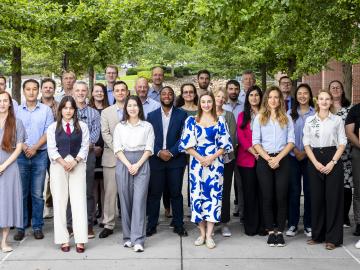
Filter News
Area of Research
- Advanced Manufacturing (3)
- Biological Systems (1)
- Biology and Environment (35)
- Clean Energy (56)
- Computational Biology (1)
- Computational Engineering (1)
- Computer Science (2)
- Electricity and Smart Grid (1)
- Fuel Cycle Science and Technology (1)
- Fusion and Fission (33)
- Fusion Energy (5)
- Isotope Development and Production (1)
- Isotopes (10)
- Materials (75)
- Materials Characterization (1)
- Materials for Computing (9)
- Materials Under Extremes (1)
- National Security (24)
- Neutron Science (33)
- Nuclear Science and Technology (24)
- Supercomputing (71)
News Type
News Topics
- (-) Artificial Intelligence (84)
- (-) Biomedical (48)
- (-) Clean Water (17)
- (-) Education (5)
- (-) Grid (41)
- (-) Materials Science (99)
- (-) Mathematics (7)
- (-) Nuclear Energy (83)
- (-) Quantum Computing (32)
- (-) Space Exploration (15)
- 3-D Printing/Advanced Manufacturing (88)
- Advanced Reactors (18)
- Big Data (36)
- Bioenergy (74)
- Biology (82)
- Biotechnology (20)
- Buildings (38)
- Chemical Sciences (59)
- Climate Change (74)
- Composites (19)
- Computer Science (149)
- Coronavirus (34)
- Critical Materials (16)
- Cybersecurity (31)
- Decarbonization (67)
- Element Discovery (1)
- Emergency (2)
- Energy Storage (73)
- Environment (141)
- Exascale Computing (39)
- Fossil Energy (5)
- Frontier (41)
- Fusion (46)
- High-Performance Computing (78)
- Hydropower (5)
- Isotopes (49)
- ITER (4)
- Machine Learning (36)
- Materials (103)
- Mercury (9)
- Microelectronics (4)
- Microscopy (36)
- Molten Salt (4)
- Nanotechnology (42)
- National Security (64)
- Net Zero (11)
- Neutron Science (102)
- Partnerships (50)
- Physics (55)
- Polymers (20)
- Quantum Science (59)
- Renewable Energy (2)
- Security (23)
- Simulation (42)
- Software (1)
- Statistics (2)
- Summit (52)
- Sustainable Energy (78)
- Transformational Challenge Reactor (7)
- Transportation (52)
Media Contacts

Three flights, five thousand miles and half a dozen clearances and permissions stood between Tetiana Maltseva and the Department of Energy’s Oak Ridge National Laboratory. When she finally arrived at the lab to represent Ukraine at the 2024 Nuclear Energy Management School, her vision was clear.
After retiring from Y-12, Scott Abston joined the Isotope Science and Engineering Directorate to support isotope production and work with his former manager. He now leads a team maintaining critical equipment for medical and space applications. Abston finds fulfillment in mentoring his team and is pleased with his decision to continue working.

A team led by scientists at ORNL identified and demonstrated a method to process a plant-based material called nanocellulose that reduced energy needs by a whopping 21%, using simulations on the lab’s supercomputers and follow-on analysis.

As a mechanical engineer in building envelope materials research at ORNL, Bryan Maldonado sees opportunities to apply his scientific expertise virtually everywhere he goes, from coast to coast. As an expert in understanding how complex systems operate, he’s using machine learning methods to control the process and ultimately optimize performance.

A research scientist with the Department of Energy’s Oak Ridge National Laboratory, Ayana Ghosh was named the 2024 Early Discovery Award winner by the American Ceramic Society. The award recognizes an early career member of the organization who has contributed to basic science in the field of glass and ceramics.

Researchers for the first time documented the specific chemistry dynamics and structure of high-temperature liquid uranium trichloride salt, a potential nuclear fuel source for next-generation reactors.

DOE commissioned a neutron imaging instrument, VENUS, at the Spallation Neutron Source in July. VENUS instrument scientists will use AI to deliver 3D models to researchers in half the time it typically takes.

A study by more than a dozen scientists at the Department of Energy’s Oak Ridge National Laboratory examines potential strategies to integrate quantum computing with the world’s most powerful supercomputing systems in the pursuit of science.
Researchers at ORNL recently demonstrated an automated drone-inspection technology at EPB of Chattanooga that will allow utilities to more quickly and easily check remote power lines for malfunctions, catching problems before outages occur.

The Quantum Computing User Forum welcomed attendees for a dynamic event at ORNL. The annual user meeting brought the cohort together to highlight results and discuss common practices in the development of applications and software for quantum computing systems.


